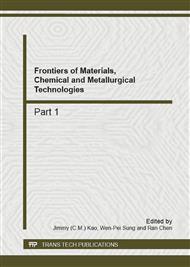[1]
X. Luo, H. Zhan, X. Chai, S. Fu, J. Liu, A novel method for determination of aromatic aldehyde monomers in lignin degradation liquor, Ind. Eng. Chem. Res. 48 (2009) 2713–2716.
DOI: 10.1021/ie801734n
Google Scholar
[2]
P.C. Rodrigues Pinto, E.A. Borges da Silva, A.E. Rodrigues, Insights into oxidative conversion of lignin to high-added-value phenolic aldehydes, Ind. Eng. Chem. Res. 50 (2011) 741–748.
DOI: 10.1021/ie102132a
Google Scholar
[3]
P.C. Rodrigues Pinto, E.A. Borges da Silva, A.E. Rodrigues, Comparative study of solid-phase extraction and liquid-liquid extraction for the reliable quantification of high value added compounds from oxidation processes of wood-derived lignin, Ind. Eng. Chem. Res. 49 (2010. ) 12311–12318.
DOI: 10.1021/ie101680s
Google Scholar
[4]
M. Makni, Y. Chtourou, H. Fetoui, E.M. Garoui, T. Boudawara, N. Zeghal, Evaluation of the antioxidant, anti-inflammatory and hepatoprotective properties of vanillin in carbon tetrachloride-treated rats, Eur. J. Pharmacol. 668 (2011) 133–139.
DOI: 10.1016/j.ejphar.2011.07.001
Google Scholar
[5]
H.R. Bjørsvik, L. Liguori, Organic processes to pharmaceutical chemicals based on fine chemicals from lignosulfonates, Org. Process Res. Dev. 6 (2002) 279–290.
DOI: 10.1021/op010087o
Google Scholar
[6]
X.H. Yang, P.H. Zhang, Y.H. Zhou, C.G. Liu, X.Y. Lin, J.F. Cui, Synthesis and antioxidant evaluation of novel 4-aryl-hexahydroquinolines from lignin, ARKIVOC (2011) 327–337.
DOI: 10.3998/ark.5550190.0012.a27
Google Scholar
[7]
X.H. Yang, P.H. Zhang, Y.H. Zhou, J.S. Wang,.H.J. Liu, Synthesis and Antioxidant Activities of Novel 4, 4'-Arylmethylene-bis(1H-pyrazole-5-ol)s from Lignin, Chin. J. Chem. 30 (2012) 670–674.
DOI: 10.1002/cjoc.201280009
Google Scholar
[8]
X.H. Yang, Pi.H. Zhang, L.H. Hu, M. Zhang, C.G. Liu, H.J. Liu , Y.H. Zhou, Synthesis and bioactivity evaluation of lignin related high-added-value 1, 4-dihydropyridines and polyhydroacridines, Ind. Crop. Prod. 38 (2012) 14–20.
DOI: 10.1016/j.indcrop.2011.12.035
Google Scholar
[9]
X. Dong, M. Dong, Y. Lu, A. Turley, T. Jin, C. Wu, Antimicrobial and antioxidant activities of lignin from residue of corn stover to ethanol production, Ind. Crop. Prod. 34 (2011) 1629–1634.
DOI: 10.1016/j.indcrop.2011.06.002
Google Scholar
[10]
P. Nordell, P. Lincoln, Mechanism of DNA threading intercalation of binuclear Ru complexes: uni- or bimolecular pathways depending on ligand structure and binding density, J. Am. Chem. Soc. 127 (2005) 9670–9671.
DOI: 10.1021/ja0521674
Google Scholar
[11]
H.S. Chung, W.S. Woo, A quinolone alkaloid with antioxidant activity from the aleurone layer of anthocyanin-pigmented rice, J. Nat. Prod. 64 (2001) 1579–1580.
DOI: 10.1021/np010324g
Google Scholar
[12]
M. Sedic, M. Poznic, P. Gehrig, M. Scott, Differential antiproliferative mechanisms of novel derivative of benzimidazo[1, 2-α]quinoline in colon cancer cells depending on their p.53 status, Mol. Cancer Ther. 7 (2008) 2121–2132.
DOI: 10.1158/1535-7163.mct-07-2261
Google Scholar
[13]
O.A. El-Sayed, T.M. Al-Turki, H.M. Al-Daffiri, B.A. Al-Bassam, M.E. Hussein, Tetrazolo[1, 5-α] quinoline derivatives as anti-inflammatory and antimicrobial agents, Boll. Chim. Farm. 2004, 143, 227–238.
Google Scholar
[14]
G. Gakhar, T. Ohira, A. Shi, D.H. Hua, T.A. Nguyen, Antitumor effect of substituted quinolines in breast cancer cells, Drug Dev. Res. 69 (2009) 526–529.
DOI: 10.1002/ddr.20281
Google Scholar
[15]
Y.L. Chen, K.C. Fang, J.Y. Sheu, S.L. Hsu, C.C. Tzeng, Synthesis and antibacterial evaluation of certain quinolone derivatives, J. Med. Chem. 44 (2001) 2374–2377.
DOI: 10.1021/jm0100335
Google Scholar
[16]
R.L. Caia, M. Li, S.H. Xie, Y. Song, Z.M. Zou, C.Y. Zhu, Y. Qi, Antihypertensive effect of total flavone extracts from Puerariae Radix, J. Ethnopharmacol. 133 (2011) 177–183.
DOI: 10.1016/j.jep.2010.09.013
Google Scholar


